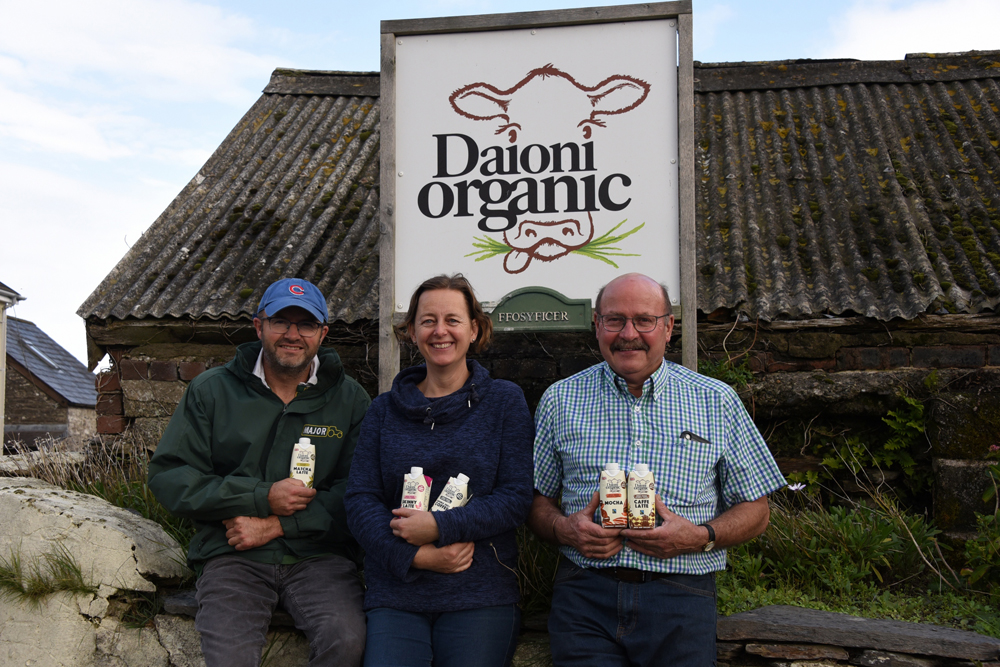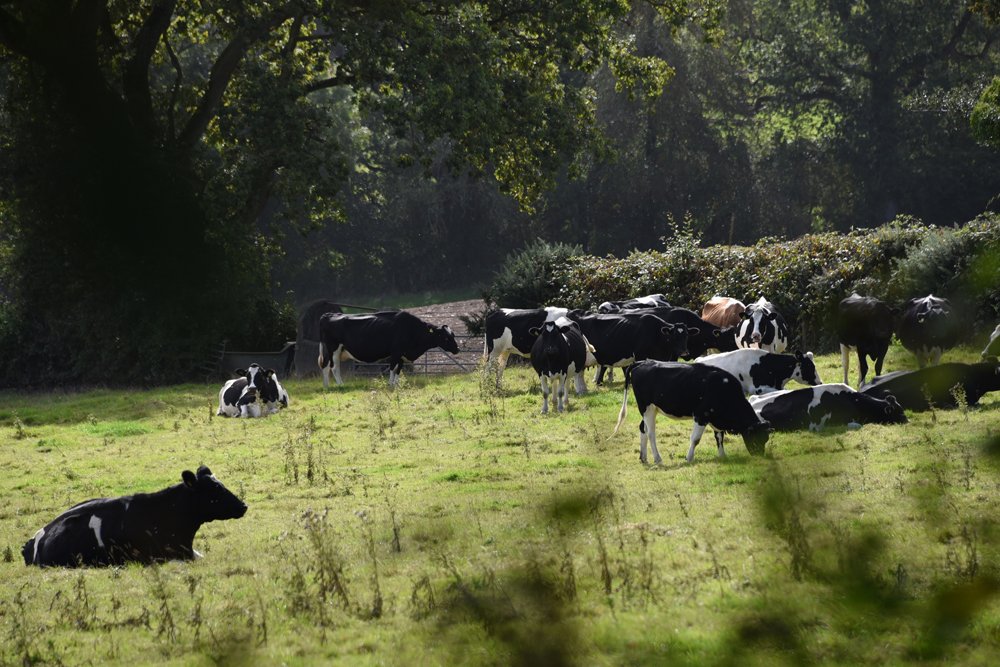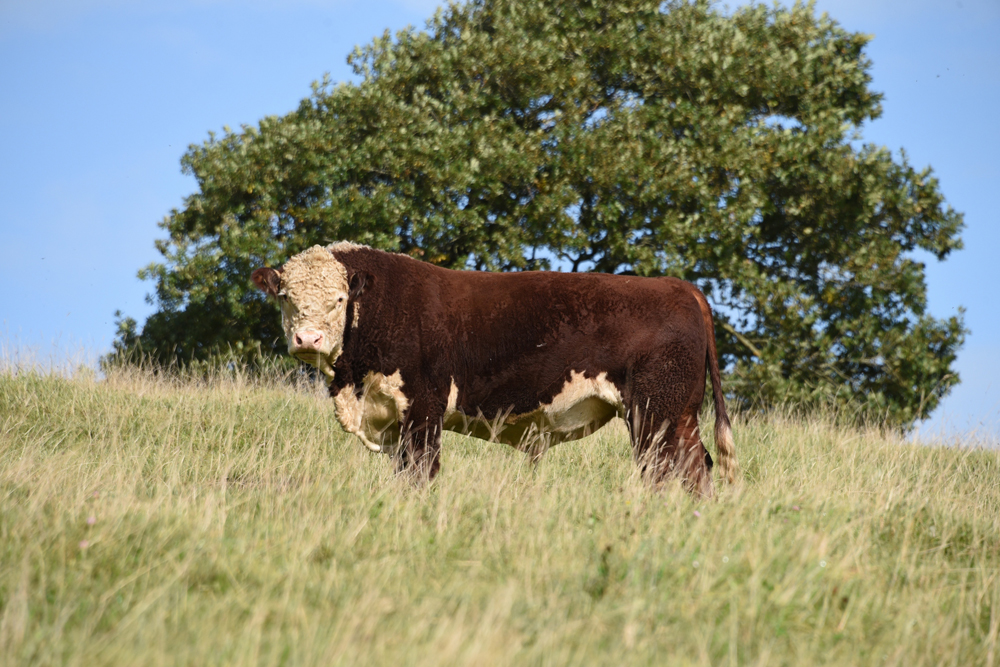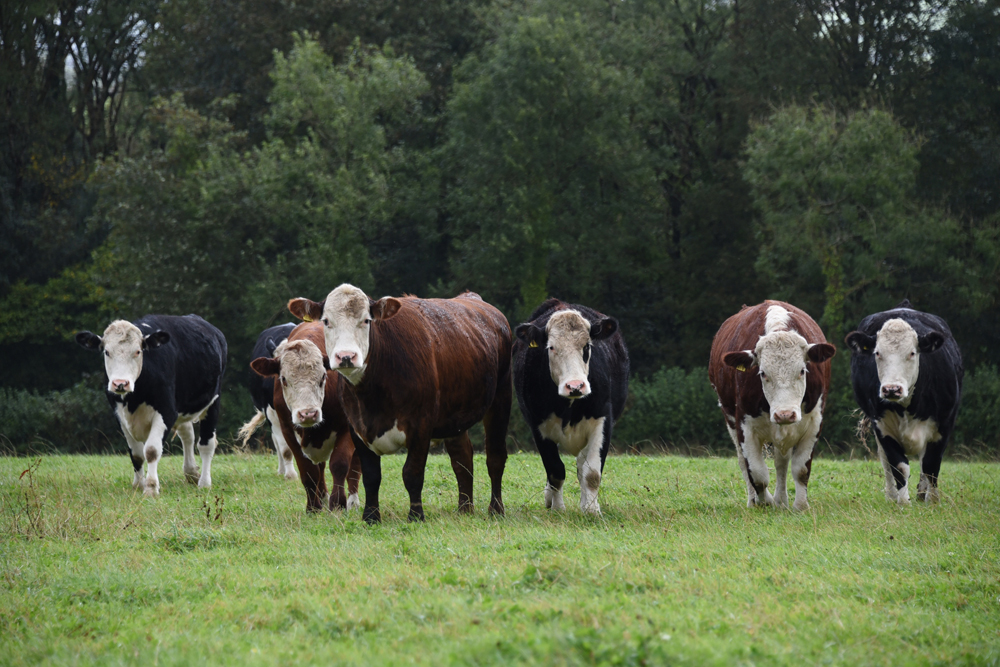

L-R: Tom, Francisca and Laurence Harris
Breeding sweeper bulls to use on his dairy cows gives milk producer Laurence Harris control over herd biosecurity. For two decades, his breed of choice has been the Hereford.
Laurence Harris is a dairy farmer who doesn’t shy away from scale. As the founder of a multi-million pound organic flavoured milk company and a partner in a dairying farming enterprise just short of 1,000 cows, numbers don’t faze Laurence.
To succeed at scale the minutiae must be spot on and, in his situation, this includes the performance of the bulls he runs with the herd after two rounds of AI to pick up any that are not in-calf.
Laurence has used the Hereford for this job for nearly two decades, a breed that first caught his eye in the late 1960s, back in the day when he was a student in agriculture at Cirencester.
By then he was married to Eira and the couple rented a cottage from Walter Clark, a world-renowned Hereford breeder and owner of the Lowesmoor herd.
He says: “Wally was already selling animals to South America, for 5,000gns each,’’ Laurence recalls. “At that time you could buy a cottage on the outskirts of Cirencester for £1,000 so 5,000gns was a lot of money.’’
Laurence was taken by the Hereford even back then. “I remember thinking at that time that Herefords might be a bit of a hobby of mine in the future, that when I retired I wouldn’t mind owning a herd of those.’’
Now in his seventies and not yet contemplating retirement, Laurence’s association with the Hereford would come many years earlier than he had anticipated.
By the early 2000s he had built up the dairy herd at Ffosyficer near Abercych, Pembrokeshire, and, after several years of only using dairy sires to produce the number of replacements he needed, he was keen to establish a small beef herd to produce sweeper bulls to breed with the dairy cows.
And so he bought six in-calf heifers from Walter’s son, Michael, who had taken on responsibility for the Lowesmoor herd. “Eira and I used to babysit Michael, I never thought that one day I would be buying heifers from him!’’ laughs Laurence.
He registered the poll herd under the Teifiside prefix and now has 15 suckler cows.
These are sired with Hereford stock bulls sourced from pedigree herds to produce the sweeper bulls Laurence uses on his dairy herds.
Breeding his own bulls gives him control of biosecurity, an important factor given that his farm is in a high risk TB region.
The business has 20 sweeper bulls, in equal numbers of young and older animals, to run with the dairy herds the Harris family milk at three different farms.
At Ffosyficer, the holding where the farming enterprise has its foundations, there is an autumn calving herd of 370 cows.
In 2006, the family acquired another farm nearby, Ffynnonwen, and a spring calving herd was established to complement the autumn milk system; this allowed for an all year-round supply of organic milk for the products the Harris family produce under the Daioni brand.

Now milking 300 cows at Ffynnonwen, there is now another 300 at Rhosmaen, a holding near Newport, Pembrokeshire, which they took on three years ago and also run as a spring-calving unit.
The herds are all managed by Laurence and Eira’s son and daughter-in-law, Tom and Francisca, allowing Laurence to concentrate on growing the Daioni business.
There is also a flock of 2,000 Easycare ewes and 500 acres (202 hectares) of combinable crops are grown.
There is a common theme with the cow type in all three milking herds being mostly New Zealand Friesians and run on a grass-based system but supplemented with home-grown arable crops.
At breeding, the cows get two rounds of AI using dairy breeds and at six weeks the sweeper bulls are introduced. One of the reasons why Laurence favours the Hereford over other beef breeds is calving ease.
“Easy calving is a must, very few need assistance,’’ he says.
And, with so many bulls on the farm, docility is a prerequisite.
“They are a very quiet breed, too quiet sometimes as it can be difficult to get them to move when there are routine jobs to be done,’’ Laurence jokes.
He chooses to breed sweeper bulls rather than buying them to protect biosecurity.
“We like the cattle to have local immunity, to be able to resist diseases that bought-in animals are more likely to succumb to,’’ he explains.
Bull size is a consideration so the sweepers are only used for four years.
“They have to be fairly light because we run them in the yards with the cows when they are sweeping because of the time of the year, we don’t use them for longer than four years because they can get to quite a size,’’ Laurence explains.
The business finishes all the Hereford cross-bred calves produced by the dairy cows, around 120 to 140 a year.
The autumn-born cross-breds are turned out to grass at six months and graze on stubble turnips in their second winter.
“They can stand being out on stubble turnips and straw in the winter, and out-winter well. They are also easy to manage which is key given the numbers of stock we have,’’ says Laurence.
Some fatten in their second grazing summer, finishing at an average of 22 months. Laurence says the cross-breds don’t need top quality grazing to perform well and need little supplementation.
“They produce a good carcase off second quality forage. They do not need a lot of TLC. They graze on old leys that cannot be part of the farm’s arable rotation. These areas are mostly under environmental schemes that protect the old meadows.
To make the system as efficient as possible, good growth rates are vital, Laurence adds.
“There is an organic premium but it is not significant, therefore we need to produce the cattle as efficiently and as cheaply as we can. We selectively start feeding a bit of grain in July, it is a matter of trying to get them off the farm as early as possible but we don’t want them all finishing at the same time.’’
All the cross-bred beef cattle are sold by March, mostly to St Merryn Meats to supply Tesco but with some sold to a local butcher, Tom Samways, who has a shop in Cardigan. The cattle kill out at 270 to 280kg deadweight, achieving R or O conformation grades and a fat class of 3 or 4. Getting the finishing period right is important.
“The Hereford can go over-fat if you are not careful, you have to keep an eye on when they get to the right stage and sell them then,’’ says Laurence.
When it comes to selecting bulls, Laurence admits he is becoming more discerning.
“It is no longer the case that it just needs a white face,’’ he says.
The stock bulls which he mates with the pure-bred Hereford herd have included Lowesmore Collosus.
“He has really put his stamp on the herd,’’ says Laurence.
And another bull that has had a big influence is Ashdale Regent, bought from George and Ionwy Thorne, of Studdolph Herefords, Steynton, Pembrokshire 11 years ago and still working.
“We have also bought four young bulls from the Tydesmoor herd in Derby and we bought an in-calf cow from Aled Jones at Caersws and kept the resulting bull calf for breeding,’’ says Laurence.
He keeps a close eye on local Hereford breeders.
“I have a look at what they are up to, I look for the shape of the bull, the conformation of the female.’’
There are many practical reasons for Laurence’s enduring devotion to the Hereford breed while others, he says, are more aesthetic.
“They are very pleasant to look at,’’ he says.

Adding value to milk
As the dairy farming enterprise has grown so too has Daioni, a business that was established in 2001 after Laurence became disheartened with the price he was paid for his milk.
Although he had no experience of sales or processing, his decision to create a range of organic, naturally flavoured milks wasn’t a leap in the dark. Laurence had done his research, identifying a gap in the market as no similar product was being sold in the UK at that time.
Fast-forward to 2019 and more than three million litres of flavoured and fresh organic milk are sold annually under the Daioni brand. The business is achieving year on year growth of both product lines and exporting to the Middle East and to the Asia Pacific region including China.
And the company has just launched five new flavours based around the theme of coffee and matcha, which is a green tea product.
From the original farm activity in 1975 the farm and resulting dairy business now operates worldwide with a turnover in excess £4.5 million.
To support the expansion of the new business, Laurence and Eira’s son, Tom, who had been working as a post–doctorate research scientist in America until 1999, returned home to farm.
“Strong family support has been the key to Daioni’s success,’’ says Laurence.
For a product to sell it needs to taste good. The business was supported by Food Centre Wales at Horeb in Ceredigion. An expert, a consultant who owned a small plant producing UHT milk, was drafted in and five versions of each flavour – strawberry, banana and chocolate – were sampled.
“Through trial and error we came up with our award-winning recipe,’’ says Laurence. “By happy co-incidence the recipe we settled on was less than 5 per cent sugar which meant we are able to supply schools.’’
Initially, the organic milk was transported by the company’s own tanker to Tomlinsons in Wrexham but this is now in the hands of OMSCo.
“OMSCo collects all of our milk and delivers organic milk back to us after processing,’’ Laurence explains.
All production of the UHT flavoured milks now takes place at Framptons in Shepton Mallet – this contract was initially with Crediton Dairy but the switch was made as demand increased.
“Crediton could not continue to pack our increasing order book but we left on good terms,’’ says Laurence.
On-farm processing was never an option Laurence wanted to pursue.
“The capital investment doesn’t justify it, buying another farm was a much safer bet and it would also have added an extra tier of work. I keep tractors and combines, I don’t want to be dealing with processing machinery packing up too,’’ says Laurence.
Family support has been an enormous help. Tom and his wife, Francisca, are at home directing farming operations while Laurence and Eira’s younger son, Ben, and his wife, Natalie, live in Hong Kong and are an integral part of the export business.
“Their advice on ‘doing business’ with China was invaluable,’’ says Laurence.
Daioni had previously dipped its toe in the export market with support from the Welsh Government but establishing a market in China was a significant milestone.
The company has set up offices in both Shanghai and Hong Kong, which are overseen by Ben.
Working in the value-added sector has made Laurence appreciate the margins that must be achieved by everyone who handles the product.
“The label, the top and the bottle all have a price and it does add up. Everyone has to make a cut.’’

Farm facts
1,416.4 hectares (3,500 acres) farmed
Two 300 cow spring calving herds at Ffynnonwen and Rhosmaen
370 cow autumn-calving herd at Ffosyficer
Herds run on a grass-based system, supplemented with home-grown arable crops.
Milk sold to OMCSo
2000 Easycare ewes and a small flock of Glamorgan Welsh Mountains
500ac (202ha) of combinable crops
Farm enterprise was converted to organic production in 1999 due to concerns about intensive agriculture
Annual rainfall ranges between 168cm (66 inches) at Ffynnonwen and 86 (34 inches) at Ffosyficer